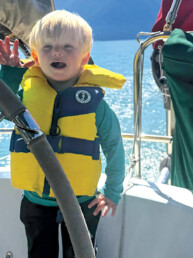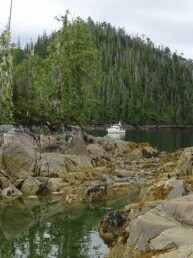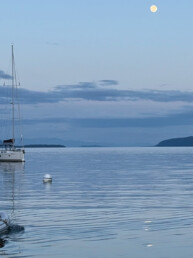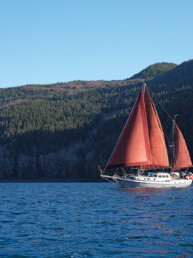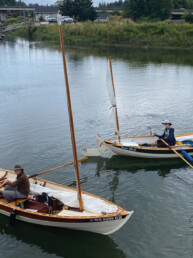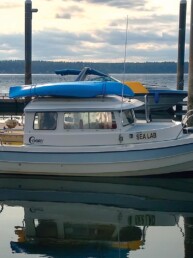The ever-evolving lessons of raising kids on a sailboat in the Pacific Northwest
Sitting at a table on the patio of Seattle’s Nickerson Street Saloon, Jill and I celebrated the closing of our new-to-us 1984 Grand Soleil 39 over cold beers and a rousing game of Yahtzee. It was early July 2012, and we excitedly talked about cruising plans for the rest of the summer and beyond, and about starting a family. We also renamed our new home right on the spot—Yahtzee.
My, my, how things have changed. While living-aboard at Shilshole Bay Marina for two years we sailed Yahtzee as much as we could. We also welcomed our first son, Porter, into the world, and hatched a plan to cut the dock lines and cruise the Pacific Northwest and Alaska full-time. At that point we’d never even been to the San Juan Islands, so we had a lot of ground to cover.
Turns out, we’ve done just that. In September 2014, we gave up our slip, sold our car, and headed north for the San Juan Islands and beyond. Our goal was simple: Cast off, explore, make memories, and live each day in the moment together.
Magnus joined our crew in Bellingham in late 2014 and we spent 2015 exploring British Columbia’s Gulf Islands, Sunshine Coast, Desolation Sound, and more. In April 2016, we sailed down to the Columbia River and cruised as far up as Portland before participating in the 40th Oregon Offshore Race from Astoria, OR, to Victoria, BC. From Victoria, we spent three spectacular months cruising around Vancouver Island and then enjoyed another winter cruising the San Juan and Gulf islands.
In February 2017 we left the San Juans and sailed north up the outside of Vancouver Island, on to Haida Gwaii and arrived in Alaska in late April. After cruising throughout Southeast for two months, we sailed across the Gulf of Alaska to Kodiak Island, the Kenai Peninsula and Prince William Sound. Of course, we couldn’t get enough of the The Last Frontier and ended up living in Seward through two winters. We left Seward in May 2019 to cruise more of Alaska for the summer before finally turning south.
Along the way, other parents often ask us how it is raising the boys on a sailboat and what the challenges are. Whether they are aspiring to the cruising lifestyle themselves or are merely curious, their many questions are usually valid and our answers typically boil down to, “This is what works for us.” We say this because, like many things in cruising and life in general, the way we make things work might not be how someone else does it—and that’s fine. Here’s what has worked for us over the years.
Safety First
When discussing boating with kids, let alone raising children on a cruising sailboat, it’s important to start with safety, and it tends to be one of the first questions we get asked. Our steadfast rule for Porter and Magnus is that once they step up out of the companionway they need to either be in a lifejacket or clipped in with a tether and harness. And if they’re on a dock, a lifejacket is on no matter what. That’s just prudent seamanship with kids aboard, let alone parenting. Also, it’s the law.
It should be noted here that the United States Coast Guard requires children 12-years-old and younger to wear an approved PFD on a vessel underway. States and Canadian Provinces have their own laws regarding life jacket use, too, so check accordingly wherever you plan to cruise.
For lifejackets, we’ve gone with the infant neoprene type (0 to 30 pounds) from West Marine that have the head flap and crotch strap, and then moved on to the larger Mustang vests (30 to 50 pounds). For toddlers or non-swimmers, we like having the head flap on a PFD, as it helps keep their face out of the water once the jacket rolls them onto their back.

Along with PFDs, we bought harnesses for the boys at REI that are actually kids climbing harnesses. The Fragle by Edelrid is an excellent choice over other “marine” kids harnesses because it has leg straps, not just a single crotch strap, and it fits comfortably over the shoulders, and around the legs and torso. It also has a clip-in point on the chest and back, allowing both boys to regularly go up the mast on a halyard. For tethers, we prefer the elastic safety tether from West Marine.
In addition to PFDs and harnesses, we installed lifeline netting around the outside of the boat. I don’t know if it’s more of a safety or peace-of-mind thing, but it has definitely saved a few tools and toys from going overboard.
In an odd sort of way, the unknowns for our boys are actually known and routine. And waking up in a new anchorage can be as regular an occurrence as brushing their teeth.
We also have numerous simple rules such as no wearing socks on deck, no toys out of the cockpit, and ask an adult before getting on a dock or dinghy, or climbing into the rigging.
Be social, lead by example
After safety, the next most common question we get is about how the boys are socialized. From a perspective outside of sailing, it’s easy to understand why the myth that cruising kids lack social opportunities persists. People have the misconception that children who live on cruising sailboats simply aren’t getting an appropriate level of social interaction like their land-based peers. While the concern is appreciated, it’s often misguided. After all, it’s not like we never touch land.
Over the years we’ve found excellent opportunities for socialization ashore in libraries, community centers, playgrounds, and amongst the cruising community itself. When we stopped in Seward, we were also happy to enroll them in shoreside activities including soccer, basketball, baseball, and days spent at a drop-in preschool.
The big thing we’ve noticed with Porter and Magnus is that if we are social as parents, they pick up on that and follow our lead. Jill and I actively seek out and embrace friendships with other cruising families and it has been a joy to watch the boys grow and make friends. It’s also notable that their social interactions don’t vary that much based on age. They regularly play with kids older or younger than them, and they interact and converse exceptionally well with adults—which is often true for many cruising kids.
Remain flexible, roll with the unknowns
Long before we bought Yahtzee and started sailing the Pacific Northwest, Jill and I knew that one of the keys to cruising success was having the ability to adapt to the unknown and roll with change. Life is fraught with uncertainty wherever you call home, but on a sailboat at the mercy of weather and unpredictable gear failures, the level of precariousness is heightened. And this has become even more true with two young boys on the boat.
Trying to keep strict cruising schedules and over-planning is tough on a couple, but it’s even more difficult on a family and inevitably leads to unnecessary levels of stress. That’s why we’ve approached it as a day-to-day, week-to-week, month-to-month, year-to-year journey, and have largely been taking each moment as they’ve come while not trying to over-extend ourselves.
A perfect example of this is our adventure north to Alaska. What we thought might be a spring and summer cruise north and then back down to the Salish Sea turned into a voyage spanning not just Southeast, but Kodiak Island, Prince William Sound, the Kenai Peninsula and then two winters in Seward for Jill to get a job and us to make upgrades to Yahtzee. That’s quite a change in plans!
Sure, there are times when the lack of schedule can be difficult, but we know that if we get too set on or excited about one single idea or plan, it’s likely to change. Fortunately, dealing with these unknowns can be exhilarating and incredibly freeing, and it teaches us and our boys to adapt to the many people, places, and situations that we encounter along the way.
Keep it routine
Having moved aboard Yahtzee when Porter and Magnus were hours old, the cruising life is what they know as normal and routine. Over the years, we’ve tried to exemplify living life to the fullest in a fun and responsible way, yet doing so with a sense of adventure and wonderment that sparks their creative and analytical minds. Because of this, we’re watching them grow into curious, sociable, and independent guys that know numbers and their ABCs but can also tie bowlines and tell the difference between high tide and low, and a sheet from a halyard. In an odd sort of way, the unknowns for them are actually known and routine. And waking up in a new anchorage can be as regular an occurrence as brushing their teeth.
Studies have shown that routines for kids, especially toddlers, are important for a variety of reasons, and we’ve found that they aren’t terribly difficult to keep while cruising. Whether it’s household things like maintaining a consistent bedtime, brushing teeth, completing schoolwork, having meals together, reading books, or helping with chores around the boat, the simple routines we build into their days aboard have helped immensely. Also, on-shore routines focused on having fun or spending time together such as beach fires and s’mores, going hiking, or finding swimming pools, playgrounds, and libraries together are important ways to strengthen family relationships.

While having these routines aboard and on shore may sound like it contradicts the edict of remaining flexible, it actually doesn’t. What keeps us grounded while living through uncertain cruising schedules is trying to ensure that some of these daily routines are kept largely consistent, while others remain flexible. That way, even though the boat moves along and we visit new places, our everyday patterns rarely vary. Providing the boys with that balance has certainly worked well for us over the years, and has helped them adapt and thrive in the unique life of living and cruising on a sailboat.
Deal with “stuff”
Another big part of cruising successfully as a family is managing all the stuff that comes with it—and by “stuff” I mean everything from toys and books to clothes and games, and much more.
Over the course of our seven years aboard Yahtzee—six of them with one and then two boys—we’ve whittled our stuff down to what is functional, important, and in some cases, indispensable. Not residing at a marina means that we don’t have the convenience of a dock box or pier to stash things. And we don’t have a storage unit, so we can’t hide our possessions out of sight and mind. Essentially, everything aboard Yahtzee must have a purpose—nothing more so than all the kid gear, which can pile up at an immensely fast and surprising rate.
On any sailboat, there is only so much room for food, tools, clothing, sailing gear, books, electronics, games and toys, and it all fills every storage space you have. Because of this, we highly recommend the practice that, if something new comes aboard, something else must be given away. We regularly go through our clothing, books and toys, and find that we give things away as much or more than we get. In the past few months alone, we’ve donated items in Seward, Kodiak, Sitka, and Craig. Not only are we getting rid of clutter or unnecessary items, it’s also highly satisfying to dispense of things that we no longer use or need and we’re happy if they can find a home with a new family.
Another tip is to constantly keep tweaking your storage spaces and systems until you find what works best for your boat and family. As the boys have gotten older, Jill has continuously refined their clothes storage in the V-berth and our collection of tools has recently found a home in the form of wire storage bins mounted on a previously unused bulkhead. Whatever space you have available, don’t be afraid to switch things up, try new storage combinations or invent new solutions for the “stuff” in your life.
Looking back on all the years since moving aboard in Seattle, life on Yahtzee has not solely been about how many miles we sail, or how many beautiful anchorages we visit. It’s about what makes us truly happy; being with each other while discovering the world in front of us. That’s not to say that our years of cruising with kids haven’t had their troughs and crests, but the memories we have gathered along the way are like waves on the ocean—endless.
Andy Cross
Andy Cross is the editor of 48° North. After years cruising the Pacific Northwest and Alaska with his family aboard their Grand Soleil 39, Yahtzee, they sailed south and are currently in the Caribbean Sea. You can follow their adventures at SailingYahtzee.com.

